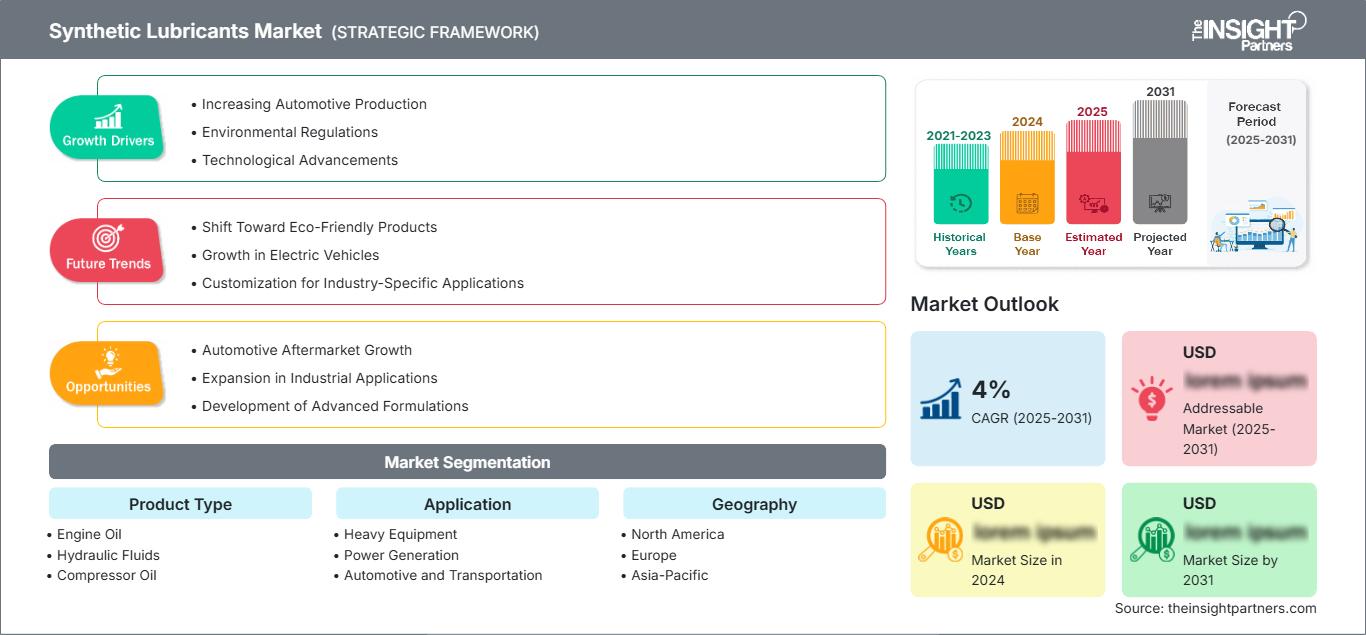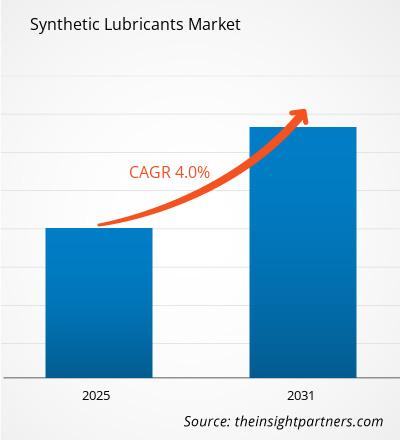Si prevede che il mercato dei lubrificanti sintetici raggiungerà i 48,5 miliardi di dollari entro il 2031. Si prevede che il mercato registrerà un CAGR del 3,5% nel periodo 2025-2031.
Il rapporto è segmentato per tipologia di prodotto (olio motore, fluidi idraulici, olio per compressori, olio per ingranaggi, fluidi per trasmissioni, olio per turbine e altri). Il rapporto presenta inoltre analisi basate sull'applicazione (attrezzature pesanti, produzione di energia, automotive e trasporti, metallurgia, nautica e altri). L'analisi globale è ulteriormente suddivisa a livello regionale e per i principali paesi. Le dimensioni e le previsioni del mercato a livello globale, regionale e nazionale per tutti i principali segmenti di mercato sono trattate nell'ambito di applicazione. Il rapporto fornisce il valore in dollari per l'analisi e i segmenti sopra indicati. Il rapporto fornisce statistiche chiave sullo stato del mercato dei principali attori e offre tendenze e opportunità di mercato.
Scopo del rapporto
Il rapporto "Synthetic Lubricants Market" di The Insight Partners mira a descrivere il panorama attuale e la crescita futura, i principali fattori trainanti, le sfide e le opportunità. Ciò fornirà spunti a vari stakeholder aziendali, come:
- Fornitori/Produttori di tecnologia: per comprendere le dinamiche di mercato in evoluzione e conoscere le potenziali opportunità di crescita, consentendo loro di prendere decisioni strategiche informate.
- Investitori: per condurre un'analisi completa delle tendenze in merito al tasso di crescita del mercato, alle proiezioni finanziarie di mercato e alle opportunità esistenti lungo la catena del valore.
- Enti di regolamentazione: per regolamentare le politiche e le attività di controllo sul mercato con l'obiettivo di ridurre al minimo gli abusi, preservare la fiducia degli investitori e sostenere l'integrità e la stabilità del mercato.
Segmentazione del mercato dei lubrificanti sintetici Tipo di prodotto
- Olio motore
- Fluidi idraulici
- Olio per compressori
- Olio per ingranaggi
- Fluidi per trasmissioni
- Olio per turbine
Applicazione
- Attrezzature pesanti
- Generazione di energia
- Automotive e trasporti
- Metallurgia
- Marina
Potrai personalizzare gratuitamente qualsiasi rapporto, comprese parti di questo rapporto, o analisi a livello di paese, pacchetto dati Excel, oltre a usufruire di grandi offerte e sconti per start-up e università
Mercato dei lubrificanti sintetici: Approfondimenti strategici

-
Ottieni le principali tendenze chiave del mercato di questo rapporto.Questo campione GRATUITO includerà l'analisi dei dati, che vanno dalle tendenze di mercato alle stime e alle previsioni.
Fattori di crescita del mercato dei lubrificanti sintetici
- Aumento della produzione automobilistica: la crescita dell'industria automobilistica, in particolare con l'aumento dei veicoli elettrici (EV), è un importante motore per i lubrificanti sintetici. Questi lubrificanti offrono prestazioni superiori, maggiore efficienza nei consumi e una maggiore durata del motore, rendendoli sempre più preferiti per i motori moderni, inclusi i veicoli elettrici ad alte prestazioni e quelli convenzionali.
- Normative ambientali: normative ambientali più severe che richiedono minori emissioni e consumi di carburante ridotti stanno stimolando la domanda di lubrificanti sintetici. Questi lubrificanti migliorano l'efficienza del motore e riducono l'impronta di carbonio, aiutando i produttori a soddisfare gli standard normativi e ad attrarre consumatori attenti all'ambiente e settori attenti alla sostenibilità.
- Progressi tecnologici: i progressi nelle formulazioni dei lubrificanti sintetici e nelle tecnologie di produzione hanno migliorato significativamente le loro prestazioni. Queste innovazioni migliorano proprietà come la stabilità termica, la resistenza all'usura e l'efficienza del carburante, rendendo i lubrificanti sintetici la scelta preferita in applicazioni impegnative come i macchinari automobilistici, aerospaziali e industriali ad alte prestazioni.
Tendenze future del mercato dei lubrificanti sintetici
- Spostamento verso prodotti ecocompatibili: vi è una crescente domanda di lubrificanti sintetici ecocompatibili e biodegradabili che riducano al minimo l'impatto ambientale. Con la crescente consapevolezza dei consumatori e la pressione normativa, i produttori si stanno concentrando sullo sviluppo di lubrificanti a minore tossicità e migliore compatibilità ambientale, rivolgendosi ai settori che danno priorità alla sostenibilità.
- Crescita dei veicoli elettrici: con la crescente diffusione dei veicoli elettrici (EV), cresce la domanda di lubrificanti sintetici progettati specificamente per i gruppi propulsori e i sistemi di batterie dei veicoli elettrici. Questi lubrificanti contribuiscono a migliorare l'efficienza, ridurre l'usura e garantire il corretto funzionamento dei componenti dei veicoli elettrici, contribuendo alla crescita complessiva del mercato dei lubrificanti sintetici nel settore automobilistico.
- Personalizzazione per applicazioni specifiche del settore: la tendenza verso lubrificanti sintetici personalizzati per applicazioni specifiche è in crescita. Settori come l'aerospaziale, l'edilizia e la produzione richiedono sempre più lubrificanti con proprietà specifiche per soddisfare le esigenze specifiche dei macchinari ad alte prestazioni, il che porta a formulazioni su misura che migliorano l'efficienza operativa e l'affidabilità.
Opportunità di mercato per i lubrificanti sintetici
- Crescita del mercato dei ricambi per autoveicoli: l'espansione del mercato dei ricambi per autoveicoli offre un'opportunità significativa per i lubrificanti sintetici. Poiché gli automobilisti richiedono lubrificanti di qualità superiore e di maggiore durata per la manutenzione dei veicoli, i produttori hanno l'opportunità di introdurre opzioni sintetiche avanzate, offrendo prestazioni migliori, risparmio di carburante e protezione del motore per soddisfare le esigenze in continua evoluzione dei clienti.
- Espansione nelle applicazioni industriali: la crescente domanda di lubrificanti ad alte prestazioni in settori come la produzione, l'estrazione mineraria e l'aerospaziale offre un potenziale di crescita. I lubrificanti sintetici, noti per la loro capacità di resistere a temperature estreme e ridurre l'usura delle attrezzature, sono sempre più richiesti in questi settori, dove durata ed efficienza sono fondamentali.
- Sviluppo di formulazioni avanzate: esiste l'opportunità di sviluppare nuove formulazioni di lubrificanti sintetici che rispondano ai settori emergenti e alle esigenze in continua evoluzione dei consumatori. Ciò include la creazione di lubrificanti con prestazioni migliorate in condizioni estreme, come sistemi ad alta pressione, temperature estreme o tipologie specifiche di macchinari, stimolando ulteriormente l'innovazione del mercato.
Le tendenze regionali e i fattori che influenzano il mercato dei lubrificanti sintetici durante il periodo di previsione sono stati ampiamente spiegati dagli analisti di The Insight Partners. Questa sezione illustra anche i segmenti di mercato e la geografia della gestione delle malattie del ritmo cardiaco in Nord America, Europa, Asia-Pacifico, Medio Oriente e Africa, America meridionale e centrale.
Ambito del rapporto sul mercato dei lubrificanti sintetici
| Attributo del rapporto | Dettagli |
|---|---|
| Dimensioni del mercato in 2024 | US$ XX Billion |
| Dimensioni del mercato per 2031 | US$ 48.5 Billion |
| CAGR globale (2025 - 2031) | 3.5% |
| Dati storici | 2021-2023 |
| Periodo di previsione | 2025-2031 |
| Segmenti coperti |
By Tipo di prodotto
|
| Regioni e paesi coperti |
Nord America
|
| Leader di mercato e profili aziendali chiave |
|
Densità degli operatori del mercato dei lubrificanti sintetici: comprendere il suo impatto sulle dinamiche aziendali
Il mercato dei lubrificanti sintetici è in rapida crescita, trainato dalla crescente domanda degli utenti finali, dovuta a fattori quali l'evoluzione delle preferenze dei consumatori, i progressi tecnologici e una maggiore consapevolezza dei benefici del prodotto. Con l'aumento della domanda, le aziende stanno ampliando la propria offerta, innovando per soddisfare le esigenze dei consumatori e sfruttando le tendenze emergenti, alimentando ulteriormente la crescita del mercato.

- Ottieni il Mercato dei lubrificanti sintetici Panoramica dei principali attori chiave
Punti di forza
- Copertura completa: il rapporto analizza in modo esaustivo prodotti, servizi, tipologie e utenti finali del mercato dei lubrificanti sintetici, fornendo un panorama olistico.
- Analisi degli esperti: il rapporto è redatto sulla base della conoscenza approfondita di esperti e analisti del settore.
- Informazioni aggiornate: il rapporto garantisce rilevanza aziendale grazie alla copertura di informazioni e dati recenti.
- Opzioni di personalizzazione: questo rapporto può essere personalizzato per soddisfare le esigenze specifiche del cliente e adattarsi in modo appropriato alle strategie aziendali.
Il rapporto di ricerca sul mercato dei lubrificanti sintetici può quindi aiutare a guidare il percorso di decodificazione e comprensione dello scenario del settore e delle prospettive di crescita. Sebbene possano esserci alcune preoccupazioni valide, i vantaggi complessivi di questo rapporto tendono a superare gli svantaggi.
- Analisi storica (2 anni), anno base, previsione (7 anni) con CAGR
- Analisi PEST e SWOT
- Valore/volume delle dimensioni del mercato - Globale, Regionale, Nazionale
- Industria e panorama competitivo
- Set di dati Excel
Report recenti
Rapporti correlati
Testimonianze
Motivo dell'acquisto
- Processo decisionale informato
- Comprensione delle dinamiche di mercato
- Analisi competitiva
- Analisi dei clienti
- Previsioni di mercato
- Mitigazione del rischio
- Pianificazione strategica
- Giustificazione degli investimenti
- Identificazione dei mercati emergenti
- Miglioramento delle strategie di marketing
- Aumento dell'efficienza operativa
- Allineamento alle tendenze normative






















 Ottieni un campione gratuito per - Mercato dei lubrificanti sintetici
Ottieni un campione gratuito per - Mercato dei lubrificanti sintetici